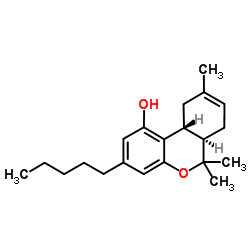(−)-trans-Δ8-tetrahydrocannabinol

(−)-trans-Δ8-tetrahydrocannabinol structure
|
Common Name | (−)-trans-Δ8-tetrahydrocannabinol | ||
|---|---|---|---|---|
| CAS Number | 5957-75-5 | Molecular Weight | 314.462 | |
| Density | 1.0±0.1 g/cm3 | Boiling Point | 383.5±42.0 °C at 760 mmHg | |
| Molecular Formula | C21H30O2 | Melting Point | N/A | |
| MSDS | N/A | Flash Point | 144.5±22.1 °C | |
| Symbol |



GHS02, GHS06, GHS08 |
Signal Word | Danger | |
| Name | 8-Tetrahydro Cannabinol |
|---|---|
| Synonym | More Synonyms |
| Density | 1.0±0.1 g/cm3 |
|---|---|
| Boiling Point | 383.5±42.0 °C at 760 mmHg |
| Molecular Formula | C21H30O2 |
| Molecular Weight | 314.462 |
| Flash Point | 144.5±22.1 °C |
| Exact Mass | 314.224579 |
| PSA | 29.46000 |
| LogP | 7.53 |
| Vapour Pressure | 0.0±0.9 mmHg at 25°C |
| Index of Refraction | 1.529 |
CHEMICAL IDENTIFICATION
HEALTH HAZARD DATAACUTE TOXICITY DATA
MUTATION DATA
|
| Symbol |



GHS02, GHS06, GHS08 |
|---|---|
| Signal Word | Danger |
| Hazard Statements | H225-H301 + H311 + H331-H370 |
| Precautionary Statements | P210-P260-P280-P301 + P310-P311 |
| Hazard Codes | F: Flammable; |
| Risk Phrases | 11-39/23/24/25-23/24/25 |
| Safety Phrases | 7-16-36/37-45 |
| RIDADR | UN 1170 |
|
Effects of cannabinoids in membrane bilayers containing cholesterol.
Biochim. Biophys. Acta 1420(1-2) , 252-65, (1999) The thermotropic and dynamic properties of the biologically active Delta(8)-tetrahydrocannabinol (Delta(8)-THC) and its inactive congener O-methyl-Delta(8)-tetrahydrocannabinol (Me-Delta(8)-THC) in DP... |
|
|
Receptor mechanism and antiemetic activity of structurally-diverse cannabinoids against radiation-induced emesis in the least shrew.
Eur. J. Pharmacol. 563(1-3) , 187-96, (2007) Xenobiotic cannabinoid CB1/CB2-receptor agonists appear to possess broad-spectrum antiemetic activity since they prevent vomiting produced by a variety of emetic stimuli including the chemotherapeutic... |
|
|
Loss of THCCOOH from urine specimens stored in polypropylene and polyethylene containers at different temperatures.
J. Anal. Toxicol. 24(7) , 567-71, (2000) The loss of delta9-tetrahydrocannabinol (THCCOOH) from urine specimens stored in polypropylene and polyethylene containers at 4 degrees C and 25 degrees C was examined. All specimens were analyzed by ... |
| 6H-Dibenzo[b,d]pyran-1-ol, 6a,7,10,10a-tetrahydro-6,6,9-trimethyl-3-pentyl-, (6aR,10aR)- |
| D8-THC |
| δ6-THC |
| δ8-Tetrahydrocannabinol |
| δ-8-THC |
| (6aR,10aR)-6,6,9-Trimethyl-3-pentyl-6a,7,10,10a-tetrahydro-6H-benzo[c]chromen-1-ol |
| δ8-THC |
| (-)-D6-3,4-trans-Tetrahydro-6,6,9-tri methyl-3-pentyl-6H-dibenzo[b,d]pyran-1-ol\ |
| 6H-Dibenzo(b,d)pyran-1-ol, 6a,7,10,10a-tetrahydro-6,6,9-trimethyl-3-pentyl-, (6aR-trans)- |
| D6-THC |
| 6H-Dibenzo[b,d]pyran-1-ol, 6a,7,10,10a-tetrahydro-6,6,9-trimethyl-3-pentyl-, (6aR-trans)- |